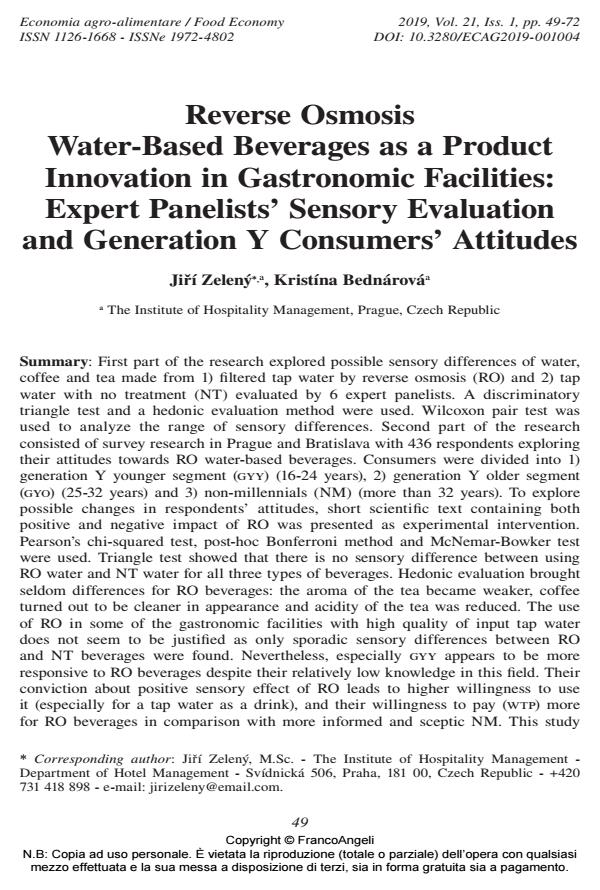Reverse Osmosis Water-Based Beverages as a Product Innovation in Gastronomic Facilities: Expert Panelists’ Sensory Evaluation and Generation Y Consumers’ Attitudes
Journal title ECONOMIA AGRO-ALIMENTARE
Author/s Jirí Zelený, Kristína Bednárová
Publishing Year 2019 Issue 2019/1
Language English Pages 24 P. 49-72 File size 232 KB
DOI 10.3280/ECAG2019-001004
DOI is like a bar code for intellectual property: to have more infomation
click here
Below, you can see the article first page
If you want to buy this article in PDF format, you can do it, following the instructions to buy download credits

FrancoAngeli is member of Publishers International Linking Association, Inc (PILA), a not-for-profit association which run the CrossRef service enabling links to and from online scholarly content.
First part of the research explored possible sensory differences of water, coffee and tea made from 1) filtered tap water by reverse osmosis (RO) and 2) tap water with no treatment (NT) evaluated by 6 expert panelists. A discriminatory triangle test and a hedonic evaluation method were used. Wilcoxon pair test was used to analyze the range of sensory differences. Second part of the research consisted of survey research in Prague and Bratislava with 436 respondents exploring their attitudes towards RO water-based beverages. Consumers were divided into 1) generation Y younger segment (gyy) (16-24 years), 2) generation Y older segment (gyo) (25-32 years) and 3) non-millennials (NM) (more than 32 years). To explore possible changes in respondents’ attitudes, short scientific text containing both positive and negative impact of RO was presented as experimental intervention. Pearson’s chi-squared test, post-hoc Bonferroni method and McNemar-Bowker test were used. Triangle test showed that there is no sensory difference between using RO water and NT water for all three types of beverages. Hedonic evaluation brought seldom differences for RO beverages: the aroma of the tea became weaker, coffee turned out to be cleaner in appearance and acidity of the tea was reduced. The use of RO in some of the gastronomic facilities with high quality of input tap water does not seem to be justified as only sporadic sensory differences between RO and NT beverages were found. Nevertheless, especially gyy appears to be more responsive to RO beverages despite their relatively low knowledge in this field. Their conviction about positive sensory effect of RO leads to higher willingness to use it (especially for a tap water as a drink), and their willingness to pay (wtp) more for RO beverages in comparison with more informed and sceptic NM. This study adheres the importance of dividing the generation Y into gyy and gyo groups since the gyo copy more NM than their own generation. When experimental intervention was done, it affected noticeable group of respondents that switched to the negative attitude towards facilities equipped with RO as well as excluded RO from their selection more than other filtration machines. This was the case of wtp too, since higher awareness about effects of RO decreased wtp across all generations. In general, RO presence was not a motive for respondents’ visits in gastronomic facility equipped with it. Respondents did not prefer RO more than other filtration machines.
Keywords: Coffee, hedonic evaluation, tea, triangle test, willingness to pay.
Jel codes: L83, L95, M31
Jirí Zelený, Kristína Bednárová, Reverse Osmosis Water-Based Beverages as a Product Innovation in Gastronomic Facilities: Expert Panelists’ Sensory Evaluation and Generation Y Consumers’ Attitudes in "ECONOMIA AGRO-ALIMENTARE" 1/2019, pp 49-72, DOI: 10.3280/ECAG2019-001004